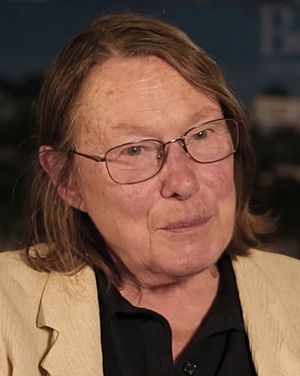Mary K. Gaillard facts for kids
Quick facts for kids
Mary K. Gaillard
|
|
|---|---|

Gaillard in 2015
|
|
| Born |
Mary Katherine Ralph
April 1, 1939 |
| Died | May 23, 2025 (aged 86) |
| Alma mater |
|
| Known for | Standard Model |
| Spouse(s) |
Jean-Marc Gaillard
(m. 1961–1983)Bruno Zumino
(m. 1984–2014) |
| Children | 3 |
| Awards |
|
| Scientific career | |
| Fields | Physics |
| Institutions | University of California, Berkeley |
| Thesis | Contribution à l'étude des interactions faibles non leptoniques (1967) |
| Doctoral advisor | Bernard d'Espagnat |
| Doctoral students |
|
Mary Katharine Gaillard (born Ralph; April 1, 1939 – May 23, 2025) was an American theoretical physicist. She was famous for her important work in particle physics, which studies the smallest pieces of matter and energy. Mary Gaillard was a professor at the University of California, Berkeley. She was also a visiting scientist at the Lawrence Berkeley National Laboratory. She was the first woman physicist to become a tenured professor at Berkeley.
Mary Gaillard made many key discoveries. She helped predict the mass of the charm quark before it was found. She also predicted 3-jet events and the mass of the b-quark. Her life story is told in her autobiography, A Singularly Unfeminine Profession, published in 2015.
Contents
Early Life and Education
Mary Katharine Ralph was born on April 1, 1939, in New Brunswick, New Jersey. She grew up in Painesville, Ohio. Her father taught history at Lake Erie College there.
College Years and Early Studies
Mary went to Hollins College in Virginia for her undergraduate degree. Her physics teacher, Dorothy Montgomery, helped her find work in France. She worked in the Louis Leprince-Ringuet laboratory for a year. She also worked at Brookhaven National Labs during a summer. She earned her bachelor's degree from Hollins in 1960. In 1961, she received her master's degree from Columbia University.
Moving to Europe and Family Life
After her first year at Columbia, she married Jean-Marc Gaillard. He was a physics student visiting from France. She moved with him to the University of Paris at Orsay, France. A year later, they moved to CERN in Geneva, Switzerland. Even though she faced sexism and had three children, she kept studying theoretical physics. She earned her first doctorate from the University of Paris at Orsay in 1964. In 1968, she completed her second doctorate in Theoretical Physics there.
Career in Physics
Mary Gaillard worked at CERN from 1964 to 1981. She was a visiting scientist, first as a student, then as a researcher. She worked for the French National Centre for Scientific Research (CNRS). She even did a survey about women scientists at CERN. This survey showed clear patterns of unfair treatment against women in hiring and pay.
Achievements in France
Despite these challenges, her scientific work at CERN was excellent. This helped her advance at CNRS. In 1979, Gaillard started a particle theory group in Annecy-le-Vieux, France. This group later became the Laboratoire d'Annecy-le-Vieux de Physique Théorique (LAPTh). She led this group from 1979 to 1981. She was also the director of research for CNRS in Annecy-le-Vieux. In 1981, she and Jean-Marc Gaillard divorced. She then returned to the United States.
Return to the United States
In 1981, Mary Gaillard joined the physics department at Berkeley. She became the first woman physics professor there. At the same time, she was a senior staff member at Lawrence Berkeley National Laboratory (LBNL). She led the Theory Group at LBNL from 1985 to 1987.
Gaillard also served on many important committees. These included groups for the American Physical Society and the Department of Energy. She was also a member of the National Science Board from 1996 to 2002.
Important Research
Mary Gaillard's research was very important in particle physics.
Key Discoveries
- She worked with Benjamin W. Lee to understand how strong forces affect weak changes. They successfully predicted the mass of the charm quark.
- With John Ellis and others, she studied what happens when electrons and positrons collide. This led to the prediction of Three-jet events.
- She also studied gauge theories and predicted the mass of the bottom quark.
- With Michael Chanowitz, she studied signs at proton-proton colliders. Their work showed that new physics must appear at very high energies.
- Later, her work focused on supergravity theories based on superstrings. She explored how these theories could explain things seen in experiments and in space.
Awards and Recognition
Mary Gaillard received many awards and honors for her contributions to physics:
- 1977: Prix Thibaud from the Academy of Sciences, Humanities and Arts of Lyon
- 1984: Fellow of the American Physical Society
- 1988: E.O. Lawrence Memorial Award from the U. S. Department of Energy
- 1989: Fellow of the American Academy of Arts and Sciences
- 1991: Member of the National Academy of Sciences
- 1993: J. J. Sakurai Prize for Theoretical Particle Physics
- 2000: Member of the American Philosophical Society
Personal Life
Mary Gaillard had three children with her first husband, Jean Marc Gaillard: Alain, Dominique, and Bruno. Later, she married Bruno Zumino. Mary Gaillard passed away on May 23, 2025, at the age of 86.
See also
 In Spanish: Mary K. Gaillard para niños
In Spanish: Mary K. Gaillard para niños

